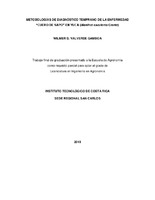| dc.contributor.author | Valverde-Gamboa, Wilmer D. | |
| dc.date.accessioned | 2016-06-10T16:37:49Z | |
| dc.date.available | 2016-06-10T16:37:49Z | |
| dc.date.issued | 2015 | |
| dc.identifier.uri | https://hdl.handle.net/2238/6464 | |
| dc.description | Proyecto de graduación (Licenciatura en Ingeniería en Agronomía) Instituto Tecnológico de Costa Rica, Escuela de Ingeniería en Agronomía, 2015 | es |
| dc.description.abstract | This study was aimed at evaluating two methods of diagnosing the cassava "frogskin" disease (CFSD) in cassava stakes. This was achieved by evaluating: (1) the presence of phytoplasma-like structures using fluorescent microscopy and (2) the presence of phytoplasma 16SrIII in different sections of cassava stake using a real-time PCR analysis. Additionally, cassava plants In vitro and asymptomatic plants were screened for the presence of phytoplasma 16SrIII to determine if the frogskin disease was present. For the fluorescent microscopy analysis, a DAPI staining technique was used in the phloem of sprouting cassava plant stems. These cassava sprouts originated from cassava stakes that were infected with the frogskin disease. The sections of cassava stake were observed using a U-FBVW filter microscope, consisting of a wavelength range of 400 to 440 nm in the excitation phase and 460 nm in the emission phase. Upon observation, phytoplasma-like structures, similar to those in histological sections of symptomatic plants, were detected. To determine the presence of phytoplasma through real-time analysis, different sections of the cassava stake were taken: phloem 1 (phloem of freshly cut cassava stake), cassava bud, phloem 2 (phloem of cassava stake after sprouting), sprouting cassava shoot, cassava root, a positive control and a negative control. The treatment that showed the best results was with the cassava root, testing 57% positive for phytoplasma. However, the cassava buds showed the least percentage of detection with a result of 11%. The real-time PCR analysis produced positive results both in symptomatic plants, as in asymptomatic and In vitro plants. | es |
| dc.language.iso | spa | es |
| dc.publisher | Instituto Tecnológico de Costa Rica | es |
| dc.rights | acceso abierto | es |
| dc.rights.uri | https://creativecommons.org/licenses/by-nc-nd/3.0/cr/ | * |
| dc.subject | Manihot esculenta Crantz | es |
| dc.subject | Enfermedades de las plantas | es |
| dc.subject | Cuero de sapo | es |
| dc.title | Metodologías de diagnóstico temprano de la enfermedad "Cuero de sapo" en yuca (Manihot esculenta Crantz) | es |
| dc.type | proyecto fin de carrera | es |



